 Three volumes of The Great Migration Begins: Immigrants to New England, 1620-1633, and seven volumes of the “second series” Great Migration: Immigrants to New England, 1634-1635, have been published since 1995. Two “spin-off” volumes – The Pilgrim Migration: Immigrants to Plymouth Colony, 1620-1633, and The Winthrop Fleet: Massachusetts Bay Company Immigrants to New England, 1629-1630, containing reprints with some updating of the subject families that first appeared in Great Migration Begins – have also been issued. Continue reading The Great Migration Study Project: a primer, Part Two
Three volumes of The Great Migration Begins: Immigrants to New England, 1620-1633, and seven volumes of the “second series” Great Migration: Immigrants to New England, 1634-1635, have been published since 1995. Two “spin-off” volumes – The Pilgrim Migration: Immigrants to Plymouth Colony, 1620-1633, and The Winthrop Fleet: Massachusetts Bay Company Immigrants to New England, 1629-1630, containing reprints with some updating of the subject families that first appeared in Great Migration Begins – have also been issued. Continue reading The Great Migration Study Project: a primer, Part Two
Monthly Archives: May 2014
Organizing a family reunion: Part Five
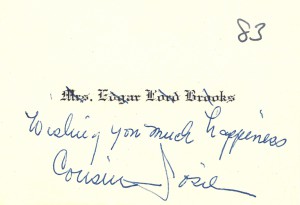 My maternal grandmother kept stationery boxes stuffed with letters and calling cards from the guests at my parents’ wedding in 1959. It’s interesting to see who was invited, since my mother’s wedding album only hints at who was there. Among the RSVPs is one from my father’s step-grandmother, who said she was coming from Florida: there is no hint of her in the album, but perhaps she was at the wedding. (I only met her once, unfortunately, although she died as recently as 2000.) Continue reading Organizing a family reunion: Part Five
My maternal grandmother kept stationery boxes stuffed with letters and calling cards from the guests at my parents’ wedding in 1959. It’s interesting to see who was invited, since my mother’s wedding album only hints at who was there. Among the RSVPs is one from my father’s step-grandmother, who said she was coming from Florida: there is no hint of her in the album, but perhaps she was at the wedding. (I only met her once, unfortunately, although she died as recently as 2000.) Continue reading Organizing a family reunion: Part Five
Further thoughts on preparing your genealogical project for publication
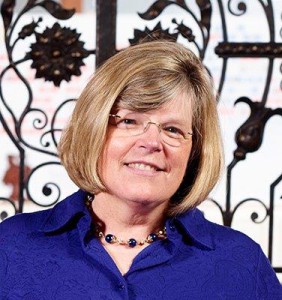 In a recent blog post on preparing a project for publication, Scott Steward targeted that essential shift in thinking that must occur as you translate your research project into a writing project. And he pointed out how important it is to write a table of contents . . . and a title.
In a recent blog post on preparing a project for publication, Scott Steward targeted that essential shift in thinking that must occur as you translate your research project into a writing project. And he pointed out how important it is to write a table of contents . . . and a title.
After talking at length with attendees at our Writing and Publishing Seminar about their projects, I realized that TOCs and titles figured large in those conversations. So here are three more thoughts on the topic: Continue reading Further thoughts on preparing your genealogical project for publication
Using the HathiTrust Digital Library
 I have access to every book, microfilm and manuscript in the NEHGS library, but because I don’t actually work in the building (I work from home, generally on a 3 pm to 3 am schedule), I have to rely on the staff at the library to make copies. Fortunately, with so many books available on-line these days, I have been accumulating my own mini-digital library using google, archive.org, and openlibrary.org. Each of these has limitations of one kind or another – e.g., poor quality of digitizing, page numbers that don’t match, lack of indexing, wait time to borrow, inability to print, etc. Continue reading Using the HathiTrust Digital Library
I have access to every book, microfilm and manuscript in the NEHGS library, but because I don’t actually work in the building (I work from home, generally on a 3 pm to 3 am schedule), I have to rely on the staff at the library to make copies. Fortunately, with so many books available on-line these days, I have been accumulating my own mini-digital library using google, archive.org, and openlibrary.org. Each of these has limitations of one kind or another – e.g., poor quality of digitizing, page numbers that don’t match, lack of indexing, wait time to borrow, inability to print, etc. Continue reading Using the HathiTrust Digital Library
Traditional research techniques – and new ones
 Robert Frost’s famous poem, The Road Not Taken, begins with his contemplation of “two roads diverg[ing] in a yellow wood,” and his indecision about whether to follow one path or the other. In the end, the author chooses what he deems “the path less traveled by.” Yet one must wonder whether another option was available? What about a possible third (or fourth or fifth) road? What about roads that have yet to be created? Sometimes, when conducting genealogical research, one must be aware of the possibility of other roads, as the mechanisms for knowing whether they exist may not yet have been developed. Occasionally, then, one must be willing to get off the known path to explore other, hidden roads. Continue reading Traditional research techniques – and new ones
Robert Frost’s famous poem, The Road Not Taken, begins with his contemplation of “two roads diverg[ing] in a yellow wood,” and his indecision about whether to follow one path or the other. In the end, the author chooses what he deems “the path less traveled by.” Yet one must wonder whether another option was available? What about a possible third (or fourth or fifth) road? What about roads that have yet to be created? Sometimes, when conducting genealogical research, one must be aware of the possibility of other roads, as the mechanisms for knowing whether they exist may not yet have been developed. Occasionally, then, one must be willing to get off the known path to explore other, hidden roads. Continue reading Traditional research techniques – and new ones
One hundred posts on Vita Brevis
In a few days, Vita Brevis will have published one hundred blog posts. Thinking back to about a year ago, when the subject of the blog was first broached, I can say that I only thought through the mechanics of preparing and posting the first half-dozen; everything after that seemed quite remote!
What can one say about the blog, circa May 2014? After a little more than five months in existence, it has played host to thirty-four bloggers, writing on topics as disparate as RootsTech 2014, the love troubles of William Norton in 1649, the antics of the Puddingstone Club in the early twentieth century, how best to use the NEHGS catalogue from home, an historical image Smack Down! between Google and Bing, and a list of the ships in the Winthrop Fleet in 1629–30. Continue reading One hundred posts on Vita Brevis
From company to colony
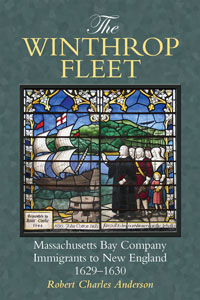 Even as the Massachusetts Bay Company was establishing itself in New England in 1630, another London-based joint-stock company, the Providence Island Company, was beginning its settlement project on a small Caribbean island off the coast of Nicaragua. The Providence Island Company was also led by Puritan gentlemen, such as the Earl of Warwick, Lord Saye and Sele, and Lord Brooke. Such men were wealthier and of much higher social status than most of the Massachusetts Bay Company members. Continue reading From company to colony
Even as the Massachusetts Bay Company was establishing itself in New England in 1630, another London-based joint-stock company, the Providence Island Company, was beginning its settlement project on a small Caribbean island off the coast of Nicaragua. The Providence Island Company was also led by Puritan gentlemen, such as the Earl of Warwick, Lord Saye and Sele, and Lord Brooke. Such men were wealthier and of much higher social status than most of the Massachusetts Bay Company members. Continue reading From company to colony
The NEHGS library collection, 2013-2014
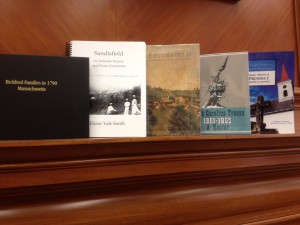 In my role as Technical Services Manager for the NEHGS library, one of my responsibilities is to develop and maintain the library collection. The library has a diverse collection of print and online books, microfilm, cd-roms, and databases to help with your genealogical research.
In my role as Technical Services Manager for the NEHGS library, one of my responsibilities is to develop and maintain the library collection. The library has a diverse collection of print and online books, microfilm, cd-roms, and databases to help with your genealogical research.
Some facts about the current collection, which is searchable through our library catalog (please note, these numbers do not include the contents of our R. Stanton Avery Special Collections): Continue reading The NEHGS library collection, 2013-2014
An enhanced Early New England Families inventory
 Readers have asked for a more detailed inventory of the Early New England Families Study Project sketches. The following list includes all sketches that have been uploaded to the website: Continue reading An enhanced Early New England Families inventory
Readers have asked for a more detailed inventory of the Early New England Families Study Project sketches. The following list includes all sketches that have been uploaded to the website: Continue reading An enhanced Early New England Families inventory
The Eliot Snider Papers
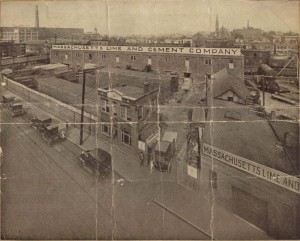 The AJHS–NEA archives are filled with stories of individuals and families who have affected the Jewish communities of Greater Boston and New England. Eliot Snider is the focus of one such collection.
The AJHS–NEA archives are filled with stories of individuals and families who have affected the Jewish communities of Greater Boston and New England. Eliot Snider is the focus of one such collection.
Four years before Eliot was born, his father – Harry, a Jewish immigrant from Lithuania – founded the Massachusetts Lime and Cement Company, later re-named Massachusetts Lumber, in Cambridge, Massachusetts. Continue reading The Eliot Snider Papers
